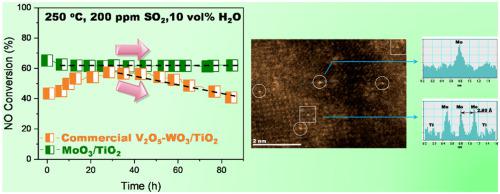Journal of Hazardous Materials ( IF 12.2 ) Pub Date : 2021-06-02 , DOI: 10.1016/j.jhazmat.2021.126289 Sufeng Guo 1 , Zhiwei Huang 1 , Lipeng Wang 1 , Xiaomin Wu 1 , Huazhen Shen 1 , Guohua Jing 1

|
Slow progress in discovering new catalysts to circumvent the problem of ammonium bisulfate (NH4HSO4, ABS) poisoning has hindered further development of selective catalytic reduction (SCR) technology of NOx with ammonia (from numerous industrial processes) in afterburning systems at temperatures below dew point of ABS (typically between 280 °C and 320 °C). Recently, we have explored the use of atomically dispersed Mo species on TiO2 particles (hereafter denoted as MoO3/TiO2) as highly efficient catalyst for NH3-SCR reaction. In the present study, it will be shown that this type of catalyst is highly resistant to ABS poisoning for NH3-SCR reaction, overcoming a major issue afflicting the application of commercial V2O5-WO3/TiO2 catalyst at temperatures below the dew point of ABS. Aberration-corrected scanning transmission electron microscopy (STEM) suggests that most of the Mo species are present in atomically dispersed form in the MoO3/TiO2 catalyst. SO2 oxidation measurements show that the MoO3/TiO2 catalyst exhibits a substantially lower SO2 oxidation rate compared to the commercial V2O5-WO3/TiO2, mitigating ABS formation. Furthermore, decomposition of ABS on MoO3/TiO2 surface is found to be extremely facile. Temperature-programmed surface reaction (TPSR) with NO shows that the decomposition temperature of ABS over MoO3/TiO2 is 70 °C lower than that found on the commercial V2O5-WO3/TiO2 catalyst. Our investigations provide valuable information for the development of NH3-SCR catalysts with exceptional resistance to ABS poisoning for NOx emission control.
中文翻译:

具有原子分散的 O-Mo-O 结构的 MoO3/TiO2 催化剂可提高抗 NH4HSO4 中毒能力以选择性催化还原氮氧化物
在发现新催化剂以规避硫酸氢铵 (NH 4 HSO 4 , ABS) 中毒问题方面进展缓慢,阻碍了在温度下后燃烧系统中用氨(来自众多工业过程)选择性催化还原 (SCR) 技术的 NO x 的进一步发展低于 ABS 的露点(通常在 280 °C 和 320 °C 之间)。最近,我们探索了在 TiO 2颗粒上使用原子分散的 Mo 物种(以下表示为 MoO 3 /TiO 2)作为 NH 3 -SCR 反应的高效催化剂。在本研究中,将表明这种类型的催化剂对 NH 3 的ABS 中毒具有很强的抵抗力-SCR反应,克服了在低于ABS露点的温度下影响商业V 2 O 5 -WO 3 /TiO 2催化剂应用的主要问题。像差校正扫描透射电子显微镜 (STEM) 表明,大多数 Mo 物质以原子分散的形式存在于 MoO 3 /TiO 2催化剂中。SO 2氧化测量表明,与商用 V 2 O 5 -WO 3 /TiO 2相比,MoO 3 /TiO 2催化剂表现出明显较低的 SO 2氧化速率, 减轻 ABS 的形成。此外,发现 ABS 在 MoO 3 /TiO 2表面上的分解极其容易。与 NO 的程序升温表面反应 (TPSR) 表明,ABS 在 MoO 3 /TiO 2上的分解温度比商业 V 2 O 5 -WO 3 /TiO 2催化剂上的分解温度低 70°C 。我们的研究为开发 NH 3 -SCR 催化剂提供了有价值的信息,该催化剂具有卓越的抗 ABS 中毒能力,用于控制NO x排放。















































 京公网安备 11010802027423号
京公网安备 11010802027423号